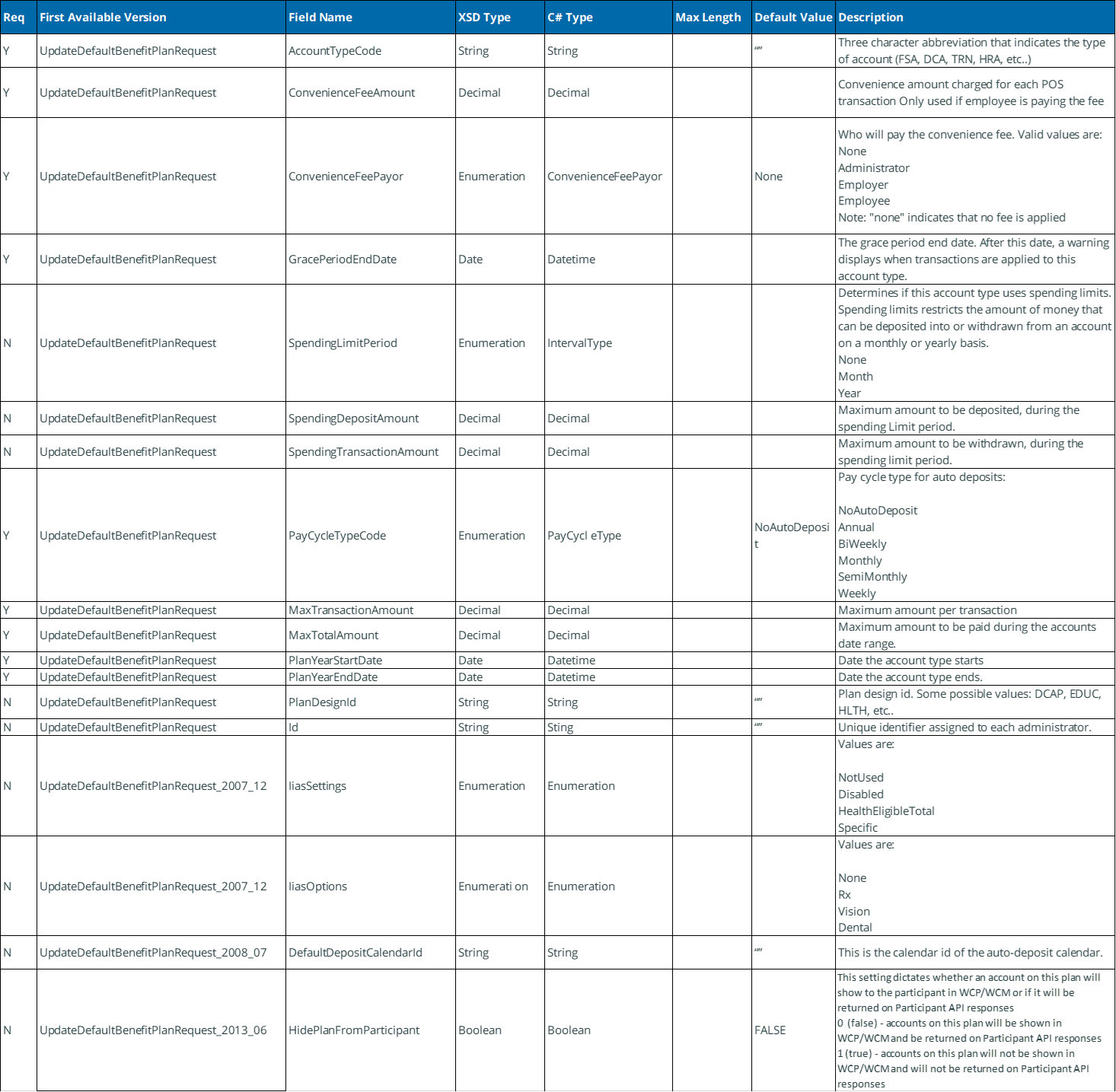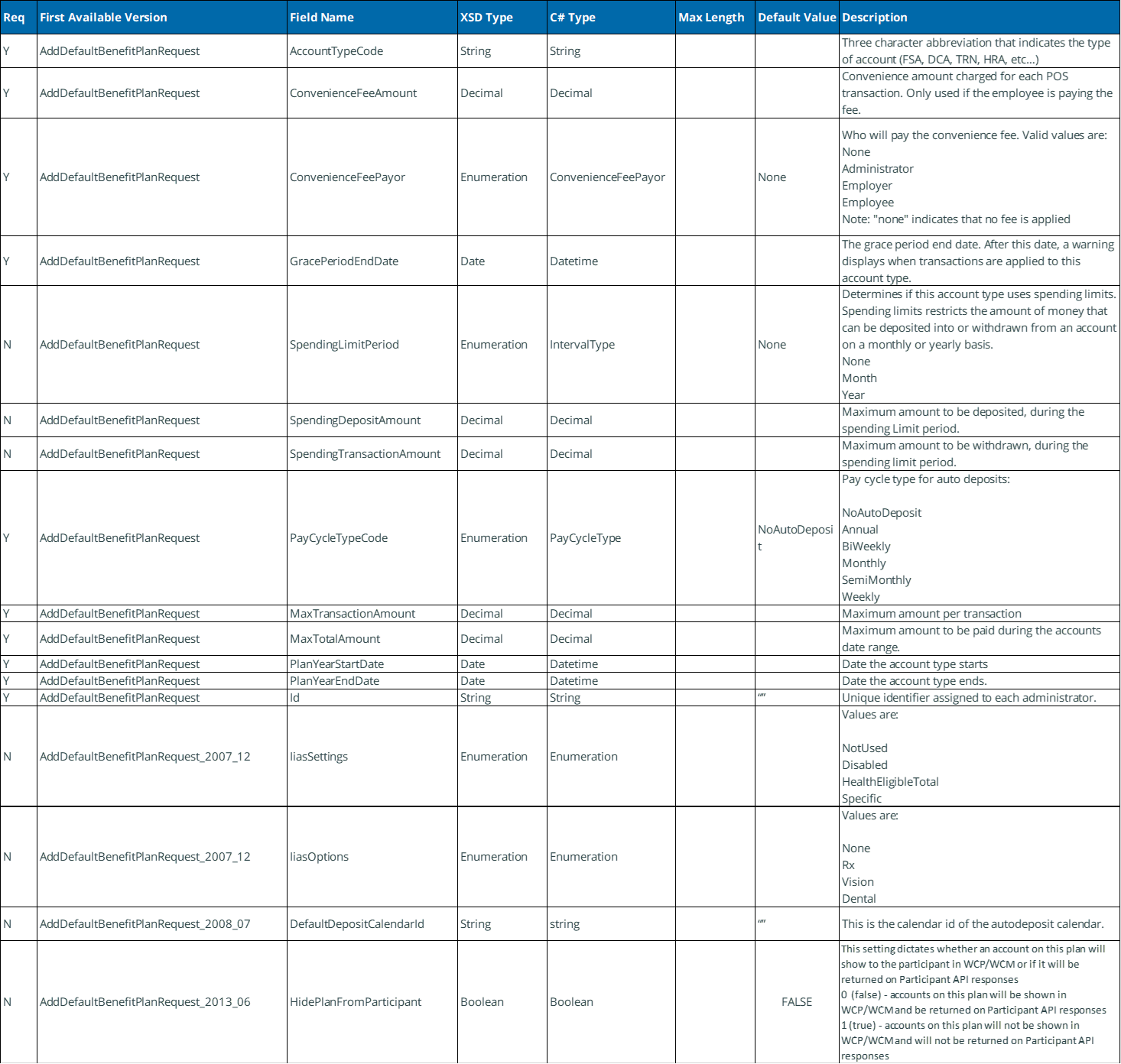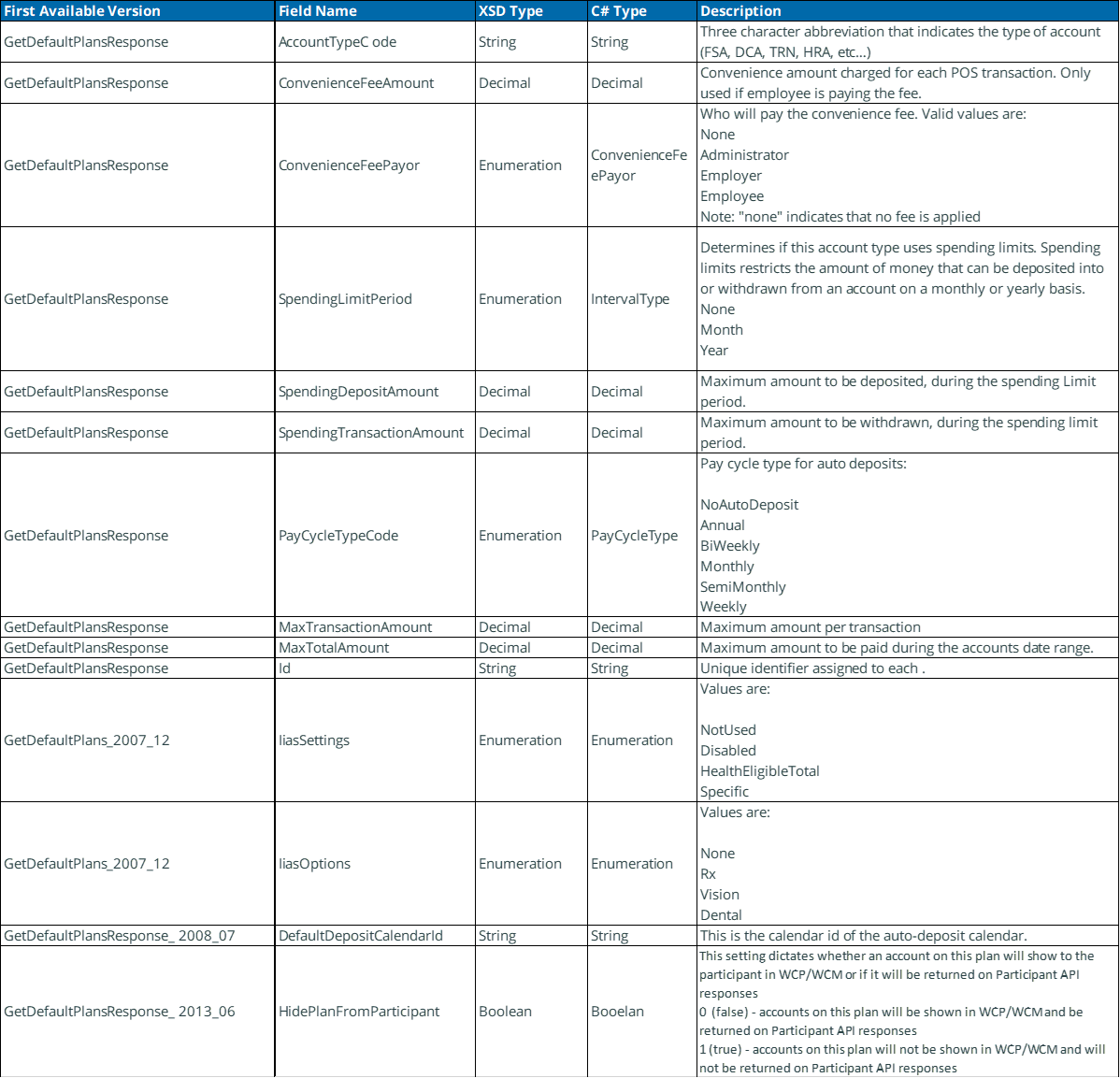
TPA Default Plan API | Administrative - SOAP
The administrator default plan service provides functionality for reading, adding, updating, and deleting default plans.
Service web methods
The following is a list of methods that are provided by the administrator default plan service.
DeleteDefaultPlan – used to delete administrator default Plan information.
UpdateDefaultBenefitPlan – used to update administrator default plan information.
AddDefaultBenefitPlan – used to add administrator default benefit plan information.
GetDefaultPlans – used to retrieve administrator default plans.
GetDefaultPlan – used to get administrator default plan information.
GetAccountTypeCodes – used to retrieve available account type codes.
Service assumptions/business rules
The DefaultPlan service makes the following assumptions as well as enforces the following business rules.
Clients shall conform to the WS-I specifications unless otherwise agreed upon by Alegeus and the administrator.
Clients shall format SOAP messages in a document/literal format over HTTPS.
Clients shall have already created a valid user ID and password.
Clients shall have a valid session ID after being authenticated by the system. The session ID needs to be passed in the proper manner as described in the account manager service guide.
If the administrator uses the same user ID and password for all of their clients, the administrator is responsible for managing the security of the data.
Clients should validate data before submitting a request to the DefaultPlan Service. This facilitates better performance and accurate processing on both systems.
Clients shall not attempt to use the DefaultPlan service for batch processing of large amounts of data. The service is designed for synchronous calls that send or retrieve small chunks of data. If batch processing is required, then the EDI process should be used.
If any method fails, the service returns a SOAP fault describing the problem.
DeleteDefaultPlan
This method is used to delete the default plan information.
History
The DeleteDefaultPlan methods are listed below:
Request message
DeleteDefaultPlanRequest
Response message
DeleteDefaultPlanResponse
DeleteDefaultPlan request/response messages
The DeleteDefaultPlan method requires the following request and response messages (input and output data). The table below includes the following request message:
DeleteDefaultPlanRequest

Response message: Empty message
Example of a DeleteDefaultPlan SOAP request message:
<?xml version="1.0" encoding="utf8" ?>
<soap:Envelope xmlns:soap="http://schemas.xmlsoap.org/soap/envelope/"
xmlns:xsi="http://www.w3.org/2001/XMLSchema-instance"
xmlns:xsi="http://www.w3.org/2001/XMLSchemainstance"
xmlns:xsi="http://www.w3.org/2001/XMLSchemainstance" xmlns:xsd="http://www.w3.org/2001/XMLSchema">
<soap:Header>
<MBISessionHeader xmlns="http://www.medibank.com/MBIWebServices/SoapHeader/">
<MBISessionID>qe4ahviw4xkhb045kipoid2b</MBISessionID>
</MBISessionHeader>
</soap:Header>
<soap:Body>
<DeleteDefaultPlanRequest xmlns="http://www.medibank.com/MBIWebServices//Messages/DefaultPlan/Request/2004/06/">
<deleteDefaultPlanRequest>
<Id>T00209</Id>
<AccountTypeCode>ACO</AccountTypeCode>
</deleteDefaultPlanRequest>
</DeleteDefaultPlanRequest>
</soap:Body>
</soap:Envelope>
Example of a DeleteDefaultPlan SOAP response message
<?xml version="1.0" encoding="utf-8" ?>
<soap:Envelope xmlns:soap="http://schemas.xmlsoap.org/soap/envelope/" xmlns:xsi="http://www.w3.org/2001/XMLSchema-instance" xmlns:xsd="http://www.w3.org/2001/XMLSchema">
<soap:Header>
<MBIMessageIdHeader xmlns="http://www.medibank.com/MBIWebServices/SoapHeader/" /> </soap:Header>
<soap:Body>
<DeleteDefaultPlanResponse
xmlns="http://www.medibank.com/MBIWebServices/Employer/Messages/EmployerLogicalBankAccount/Response/2004/06/"> < DeleteDefaultPlanResult/>
</ DeleteDefaultPlanResponse >
</soap:Body>
</soap:Envelope>
Example client code
The following is an example of the client code (using a .NET proxy class for accessing the service) used when deleting a default plan.
try
{
// Create the session SOAP header in order to pass the Service
// the client’s current session id.
mbiSessionHeader = new DefaultPlanServiceNameSpace.MBISessionHeader();
// Create proxy object for the service
proxy = new DefaultPlanServiceNameSpace.DefaultPlanService();
// Create request message for method call (input parameters)
request = new DefaultPlanServiceNameSpace.DeleteDefaultPlanRequest();
request.AccountTypeCode = _AccountTypeCode.Text;
request.Id = _Id.Text;
// session ID returned from login method
mbiSessionHeader.MBISessionID = _sessionId.Text;
proxy.MBISessionHeaderValue = mbiSessionHeader;
// Call the method
response = proxy.AddEmployerLogicalBankAccount(request);
MessageBox.Show("Finished.");
}
catch(SoapException se)
{
// perform needed operations
}
UpdateDefaultBenefitPlan
This method is used to update default benefit plan information.
History
The UpdateDefaultBenefitPlan methods are listed below:
Request message
UpdateDefaultBenefitPlan_2013_06 • UpdateDefaultBenefitPlan_2008_07
UpdateDefaultBenefitPlan_2007_12
UpdateDefaultBenefitPlanRequest
Response message
UpdateDefaultBenefitPlan request/response messages
The UpdateDefaultBenefitPlan method requires the following request and response messages (input and output data). The table below includes the following request message:
UpdateDefaultBenefitPlan_2008_07
UpdateDefaultBenefitPlan_2007_12
UpdateDefaultBenefitPlanRequest

Response Message: Empty Message
Example of an UpdateDefaultBenefitPlan SOAP request message:
<?xml version="1.0" encoding="utf8" ?>
<soap:Envelope xmlns:soap="http://schemas.xmlsoap.org/soap/envelope/"
xmlns:xsi="http://www.w3.org/2001/XMLSchemainstance" xmlns:xsd="http://www.w3.org/2001/XMLSchema"> <soap:Header>
<MBISessionHeader xmlns="http://www.medibank.com/MBIWebServices/SoapHeader/">
<MBISessionID>qe4ahviw4xkhb045kipoid2b</MBISessionID> </MBISessionHeader>
</soap:Header> <soap:Body>
<UpdateDefaultBenefitPlan xmlns= "http://www.medibank.com/MBIWebServices//Messages/DefaultPlan/Request/2004/06/" > <updateDefaultBenefitPlanRequest>
<AccountTypeCode>ACO</AccountTypeCode>
<GracePeriodEndDate>2005-12-31</GracePeriodEndDate>
<SpendingDepositAmount>0</SpendingDepositAmount>
<SpendingTransactionAmount>0</SpendingTransactionAmount>
<MaxTransactionAmount>0</MaxTransactionAmount>
<MaxTotalAmount>0</MaxTotalAmount>
<PlanYearStartDate>2005-01-01</PlanYearStartDate>
<PlanYearEndDate>2005-12-31</PlanYearEndDate>
< PayCycleTypeCode>Annual</ PayCycleTypeCode>
<Id>T00209</Id>
</updateDefaultBenefitPlanRequest>
</UpdateDefaultBenefitPlan>
</soap:Body>
</soap:Envelope>
Example of an UpdateDefaultBenefitPlan SOAP response message:
<?xml version="1.0" encoding="utf-8" ?>
<soap:Envelope xmlns:soap="http://schemas.xmlsoap.org/soap/envelope/" xmlns:xsi="http://www.w3.org/2001/XMLSchemainstance" xmlns:xsd="http://www.w3.org/2001/XMLSchema"> <soap:Header>
<MBIMessageIdHeader xmlns="http://www.medibank.com/MBIWebServices/SoapHeader/" />
</soap:Header>
<soap:Body>
<UpdateDefaultBenefitPlanResponse
xmlns="http://www.medibank.com/MBIWebServices//Messages/DefaultPlan/Response/2004/06/ ">
<UpdateDefaultBenefitPlanResult/>
</UpdateDefaultBenefitPlanResponse >
</soap:Body>
</soap:Envelope>
Example client code
The following is an example of the client code (using a .NET proxy class for accessing the service) used when updating a default plan design using the UpdateDefaultBenefitPlan web method.
try
{
// Create the session SOAP header in order to pass the Service // the client’s current session id.
mbiSessionHeader = new DefaultPlanServiceNameSpace.MBISessionHeader();
// Create proxy object for the service
proxy = new DefaultPlanServiceNameSpace.DefaultPlanService();
// Create the request object
request = new DefaultPlanServiceNameSpace.UpdateDefaultBenefitPlanRequest(); request.AccountTypeCode = _AccountTypeCode.Text;
request.ConvenienceFeeAmount = Convert.ToDecimal(_ConvenienceFeeAmount.Text); request.ConvenienceFeePayor =
(DefaultPlanServiceNameSpace.ConvenienceFeePayor)Enum.Parse(typeof(DefaultPlanServiceNameSpace.ConvenienceFeeP ayor),_ConvenienceFeePayor.Text);
if(_GracePeriodEndDate.Text.Length != 0)
{
request.GracePeriodEndDate = Convert.ToDateTime(_GracePeriodEndDate.Text);
}
request.MaxTotalAmount = Convert.ToDecimal(_MaxTotalAmount.Text); request.MaxTransactionAmount = Convert.ToDecimal(_MaxTransactionAmount.Text); request.PayCycleTypeCode =
(DefaultPlanServiceNameSpace.PayCycleType)Enum.Parse(typeof(DefaultPlanServiceNameSpace.PayCycleType),_PayCycleT ypeCode.Text);
request.PlanYearEndDate = Convert.ToDateTime(_PlanYearEndDate.Text); request.PlanYearStartDate = Convert.ToDateTime(_PlanYearStartDate.Text); request.SpendingDepositAmount = Convert.ToDecimal(_SpendingDepositAmount.Text); request.SpendingLimitPeriod =
(DefaultPlanServiceNameSpace.IntervalType)Enum.Parse(typeof(DefaultPlanServiceNameSpace.IntervalType),_SpendingLimit
Period.Text);
request.SpendingTransactionAmount = Convert.ToDecimal(_SpendingTransactionAmount.Text); request.Id = _Id.Text;
mbiSessionHeader.MBISessionID = _sessionId;
response = proxy.UpdateDefaultBenefitPlan(request);
MessageBox.Show("Finished");
}
catch(SoapException se)
{
MessageBox.Show(Formatter.FormatSoapException(se));
}
catch(Exception ex)
{
MessageBox.Show("EXCEPTION:" + ex.Message);
}
AddDefaultBenefitPlan
This method is used to add a default benefit plan.
History
The AddDefaultBenefitPlan methods are listed below:
Request message
AddDefaultBenefitPlan_2013_06
AddDefaultBenefitPlan_2008_07
AddDefaultBenefitPlan_2007_12
AddDefaultBenefitPlanRequest
Response message
AddDefaultBenefitPlanResponse
AddDefaultBenefitPlan request/response messages
The AddDefaultBenefitPlan method requires the following request and response messages (input and output data). The table below includes the following request messages:
AddDefaultBenefitPlan_2008_07
AddDefaultBenefitPlan_2007_12
AddDefaultBenefitPlanRequest

Response message: Empty message
Example of an AddDefaultBenefitPlan SOAP request message:
<?xml version="1.0" encoding="utf8" ?>
<soap:Envelope xmlns:soap="http://schemas.xmlsoap.org/soap/envelope/"
xmlns:xsi="http://www.w3.org/2001/XMLSchemainstance" xmlns:xsd="http://www.w3.org/2001/XMLSchema"> <soap:Header>
<MBISessionHeader xmlns="http://www.medibank.com/MBIWebServices/SoapHeader/">
<MBISessionID>qe4ahviw4xkhb045kipoid2b</MBISessionID> </MBISessionHeader>
</soap:Header>
<soap:Body>
<AddDefaultBenefitPlanRequest xmlns="http://www.medibank.com/MBIWebServices//Messages/DefaultPlan/Request/2004/06/">
<addDefaultBenefitPlanRequest>
<AccountTypeCode>ACO</AccountTypeCode>
<ConvenienceFeeAmount>0</ConvenienceFeeAmount>
<GracePeriodEndDate>2005-12-31</GracePeriodEndDate>
<SpendingDepositAmount>0</SpendingDepositAmount>
<SpendingTransactionAmount>0</SpendingTransactionAmount>
<MaxTransactionAmount>0</MaxTransactionAmount>
<MaxTotalAmount>0</MaxTotalAmount>
<PlanYearStartDate>2005-01-01</PlanYearStartDate>
<PlanYearEndDate>2005-12-31</PlanYearEndDate>
<PayCycleTypeCode>Annual</ PayCycleTypeCode>
<Id>T00209</Id>
</addDefaultBenefitPlanRequest>
</AddDefaultBenefitPlanRequest>
</soap:Body>
</soap:Envelope>
Example of an AddDefaultBenefitPlan SOAP response message
<?xml version="1.0" encoding="utf-8" ?>
<soap:Envelope xmlns:soap="http://schemas.xmlsoap.org/soap/envelope/" xmlns:xsi="http://www.w3.org/2001/XMLSchema-instance" xmlns:xsd="http://www.w3.org/2001/XMLSchema">
<soap:Header>
<MBIMessageIdHeader xmlns="http://www.medibank.com/MBIWebServices/SoapHeader/" />
</soap:Header>
<soap:Body>
<AddDefaultBenefitPlanResponse
xmlns="http://www.medibank.com/MBIWebServices//Messages/DefaultPlan/Response/2004/06/ "> < AddDefaultBenefitPlanResult/>
</ AddDefaultBenefitPlanResponse >
</soap:Body>
</soap:Envelope>
Example client code
The following is an example of the client code (using a .NET proxy class for accessing the service) used when adding a default benefit plan using the AddDefaultBenefitPlan web method.
try
{
// Create the session SOAP header in order to pass the Service // the client’s current session id.
mbiSessionHeader = new DefaultPlanServiceNameSpace.MBISessionHeader();
// Create proxy object for the service
proxy = new DefaultPlanServiceNameSpace.DefaultPlanService();
// Create the request object
request = new DefaultPlanServiceNameSpace.AddDefaultBenefitPlanRequest();
request.AccountTypeCode = _AccountTypeCode.Text; request.ConvenienceFeeAmount = Convert.ToDecimal(_ConvenienceFeeAmount.Text); request.ConvenienceFeePayor =
(DefaultPlanServiceNameSpace.ConvenienceFeePayor)Enum.Parse(typeof(DefaultPlanServiceNameSpace.ConvenienceFeeP ayor),_ConvenienceFeePayor.Text);
if(_GracePeriodEndDate.Text.Length != 0)
{
request.GracePeriodEndDate = Convert.ToDateTime(_GracePeriodEndDate.Text);
}
request.MaxTotalAmount = Convert.ToDecimal(_MaxTotalAmount.Text); request.MaxTransactionAmount = Convert.ToDecimal(_MaxTransactionAmount.Text); request.PayCycleTypeCode =
(DefaultPlanServiceNameSpace.PayCycleType)Enum.Parse(typeof(DefaultPlanServiceNameSpace.PayCycleType),_PayCycleT ypeCode.Text);
request.PlanYearEndDate = Convert.ToDateTime(_PlanYearEndDate.Text); request.PlanYearStartDate = Convert.ToDateTime(_PlanYearStartDate.Text); request.SpendingDepositAmount = Convert.ToDecimal(_SpendingDepositAmount.Text); request.SpendingLimitPeriod =
(DefaultPlanServiceNameSpace.IntervalType)Enum.Parse(typeof(DefaultPlanServiceNameSpace.IntervalType),_SpendingLimit Period.Text); request.SpendingTransactionAmount = Convert.ToDecimal(_SpendingTransactionAmount.Text); request.Id = _Id.Text;
mbiSessionHeader.MBISessionID = _sessionId;
response = proxy.AddDefaultBenefitPlan(request);
MessageBox.Show("Finished");
}
catch(SoapException se)
{
MessageBox.Show(Formatter.FormatSoapException(se));
}
catch(Exception ex)
{
MessageBox.Show("EXCEPTION:" + ex.Message);
}
GetDefaultPlans
This method is used to return information about the administrator’s default plans.
History
The GetDefaultPlans methods are listed below:
Request message
GetDefaultPlansRequest_2007_12
GetDefaultPlansRequest
Response message
GetDefaultPlansResponse_2008_07
GetDefaultPlansResponse_2007_12
GetDefaultPlansResponse
GetDefaultPlans request/response messages
The GetDefaultPlans method requires the following request and response messages (input and output data). The table below includes the following request messages:
GetDefaultPlans_2007_12
GetDefaultPlansRequest

The table below includes the following response messages:
GetDefaultPlans_2008_07
GetDefaultPlansResponse_2007_12
GetDefaultPlansResponse

Example of a GetDefaultPlans SOAP request message:
<?xml version="1.0" encoding="utf8" ?>
<soap:Envelope xmlns:soap="http://schemas.xmlsoap.org/soap/envelope/"
xmlns:xsi="http://www.w3.org/2001/XMLSchemainstance" xmlns:xsd="http://www.w3.org/2001/XMLSchema">
<soap:Header>
<MBISessionHeader xmlns="http://www.medibank.com/MBIWebServices/SoapHeader/">
<MBISessionID>qe4ahviw4xkhb045kipoid2b</MBISessionID> </MBISessionHeader>
</soap:Header>
<soap:Body>
<GetDefaultPlansRequest xmlns="http://www.medibank.com/MBIWebServices//Messages/DefaultPlan/Request/2004/06/">
<getDefaultPlansRequest>
<Id>T00209</Id>
</getDefaultPlansRequest>
</GetDefaultPlansRequest>
</soap:Body>
</soap:Envelope>
Example of a GetDefaultPlans SOAP response message:
<?xml version="1.0" encoding="utf8" ?>
<soap:Envelope xmlns:soap="http://schemas.xmlsoap.org/soap/envelope/"
xmlns:xsi="http://www.w3.org/2001/XMLSchemainstance" xmlns:xsd="http://www.w3.org/2001/XMLSchema"> <soap:Header>
<MBIMessageIdHeader xmlns="http://www.medibank.com/MBIWebServices/SoapHeader/">
<MessageId>da19522eaf6f4ffabdf90f3742e2c7db</MessageId>
</MBIMessageIdHeader>
</soap:Header> <soap:Body>
<GetDefaultPlansResponse xmlns="http://www.medibank.com/MBIWebServices//Messages/DefaultPlan/Response/2004/06/">
<GetDefaultPlansResult>
<GetDefaultPlansResponse>
<AccountTypeCode>DCAP</AccountTypeCode>
<ConvenienceFeeAmount>0</ConvenienceFeeAmount>
<SpendingLimitPeriod xmlns="http://www.medibank.com/MBIWebServices/Enums/">Month</SpendingLimitPeriod>
<SpendingDepositAmount>400.0000</SpendingDepositAmount>
<SpendingTransactionAmount>20.0000</SpendingTransactionAmount>
<MaxTransactionAmount>5000.0000</MaxTransactionAmount>
<MaxTotalAmount>1.0000</MaxTotalAmount>
<Id>T00209</Id>
</GetDefaultPlansResponse>
</GetDefaultPlansResult>
</GetDefaultPlansResponse>
</soap:Body>
</soap:Envelope>
Example client code
The following is an example of the client code (using a .NET proxy class for accessing the service) used when retrieving information about the default plan's using the GetDefaultPlans web method.
try
{
// Create the session SOAP header in order to pass the Service // the client’s current session id.
mbiSessionHeader = new DefaultPlanServiceNameSpace.MBISessionHeader();
// Create proxy object for the service
proxy = new DefaultPlanServiceNameSpace.DefaultPlanService();
// Create the request object
request = new DefaultPlanServiceNameSpace.GetDefaultPlansRequest(); request.Id = _Id.Text;
mbiSessionHeader.MBISessionID = _sessionId; proxy.MBISessionHeaderValue = mbiSessionHeader;
response = proxy.GetDefaultPlans(request);
}
catch(SoapException se)
{
MessageBox.Show(Formatter.FormatSoapException(se));
}
catch(Exception ex)
{
MessageBox.Show("EXCEPTION:" + ex.Message);
}
GetDefaultPlan
The GetDefaultPlan method requires the following request and response messages (input and output data). The table below includes the following request message:
GetDefaultPlan_2007_12
GetDefaultPlanRequest

The table below includes the following response message:
GetDefaultPlanResponse_2008_07
GetDefaultPlanResponse_2007_12
GetDefaultPlanResponse

Example of a GetDefaultPlan SOAP request message:
<?xml version="1.0" encoding="utf8" ?>
<soap:Envelope xmlns:soap="http://schemas.xmlsoap.org/soap/envelope/"
xmlns:xsi="http://www.w3.org/2001/XMLSchemainstance" xmlns:xsd="http://www.w3.org/2001/XMLSchema"> <soap:Header>
<MBISessionHeader xmlns="http://www.medibank.com/MBIWebServices/SoapHeader/">
<MBISessionID>qe4ahviw4xkhb045kipoid2b</MBISessionID>
</MBISessionHeader>
</soap:Header> <soap:Body>
<GetDefaultPlanRequest xmlns="http://www.medibank.com/MBIWebServices//Messages/DefaultPlan/Request/2004/06/">
<getDefaultPlanRequest>
<Id>T00209</Id>
<AccountTypeCode>ACO</AccountTypeCode>
</getDefaultPlanRequest>
</GetDefaultPlanRequest>
</soap:Body>
</soap:Envelope>
Example of a GetDefaultPlan SOAP response message
<?xml version="1.0" encoding="utf8" ?>
<soap:Envelope xmlns:soap="http://schemas.xmlsoap.org/soap/envelope/"
xmlns:xsi="http://www.w3.org/2001/XMLSchemainstance" xmlns:xsd="http://www.w3.org/2001/XMLSchema"> <soap:Header>
<MBIMessageIdHeader xmlns="http://www.medibank.com/MBIWebServices/SoapHeader/">
<MessageId>26237082be024d7ab34d32624429c7fb</MessageId>
</MBIMessageIdHeader>
</soap:Header>
<soap:Body>
<GetDefaultPlanResponse xmlns="http://www.medibank.com/MBIWebServices//Messages/DefaultPlan/Response/2004/06/"> <GetDefaultPlanResult>
<AccountTypeCode>DCAP</AccountTypeCode>
<ConvenienceFeeAmount>0</ConvenienceFeeAmount>
<GracePeriodEndDate>2005-10-29</GracePeriodEndDate>
<SpendingLimitPeriod xmlns="http://www.medibank.com/MBIWebServices/Enums/">Month</SpendingLimitPeriod> <SpendingDepositAmount>400.0000</SpendingDepositAmount>
<SpendingTransactionAmount>20.0000</SpendingTransactionAmount>
<MaxTransactionAmount>5000.0000</MaxTransactionAmount>
<MaxTotalAmount>1.0000</MaxTotalAmount>
<PlanYearStartDate>2004-10-25</PlanYearStartDate>
<PlanYearEndDate>2005-10-25</PlanYearEndDate>
<Id>T00209</Id>
</GetDefaultPlanResult>
</GetDefaultPlanResponse>
</soap:Body>
</soap:Envelope>
Example client code
The following is an example of the client code (using a .NET proxy class for accessing the service) used when retrieving a default plan using the GetDefaultPlan web method.
try
{
// Create the session SOAP header in order to pass the Service // the client’s current session id.
mbiSessionHeader = new DefaultPlanServiceNameSpace.MBISessionHeader();
// Create proxy object for the service
proxy = new DefaultPlanServiceNameSpace.DefaultPlanService();
// Create the request object
request = new DefaultPlanServiceNameSpace.GetDefaultPlanRequest(); request.Id = _Id.Text; request.AccountTypeCode = _AccountTypeCode.Text;
mbiSessionHeader.MBISessionID = _sessionId;
proxy.MBISessionHeaderValue = mbiSessionHeader;
response = proxy.GetDefaultPlan(request);
}
catch(SoapException se)
{
MessageBox.Show(Formatter.FormatSoapException(se));
}
catch(Exception ex)
{
MessageBox.Show("EXCEPTION:" + ex.Message);
}
GetAccountTypeCodes
This method is used to retrieve available account type codes.
History
The GetAccountTypeCodes methods are listed below:
Request message
GetAccountTypeCodesRequest
Response message
GetAccountTypeCodesResponse
GetAccountTypeCodes request/response messages
The GetAccountTypeCodes method requires the following request and response messages (input and output data). The table below includes the following request message:
GetAccountTypeCodesRequest

The table below includes the following response message:
GetAccountTypeCodesResponse

Example of a GetAccountTypeCode SOAP request message:
<?xml version="1.0" encoding="utf8" ?>
<soap:Envelope xmlns:soap="http://schemas.xmlsoap.org/soap/envelope/"
xmlns:xsi="http://www.w3.org/2001/XMLSchemainstance" xmlns:xsd="http://www.w3.org/2001/XMLSchema"> <soap:Header>
<MBISessionHeader xmlns="http://www.medibank.com/MBIWebServices/SoapHeader/">
<MBISessionID>nj1jnh55me0skhj2gzcgja55</MBISessionID>
</MBISessionHeader>
</soap:Header> <soap:Body>
<GetAccountTypeCodes xmlns="http://www.medibank.com/MBIWebServices//Messages/DefaultPlan/Request/2004/06/"> <getAccountTypeCodesRequest>
<Id>T00209</Id>
<TypeCode xmlns="http://www.medibank.com/MBIWebServices/Enums/">PlanDesign</TypeCode> </getAccountTypeCodesRequest>
</GetAccountTypeCodes>
</soap:Body>
</soap:Envelope>
Example of a GetAccountTypeCode SOAP response message:
<?xml version="1.0" encoding="utf8" ?>
<soap:Envelope xmlns:soap="http://schemas.xmlsoap.org/soap/envelope/"
xmlns:xsi="http://www.w3.org/2001/XMLSchemainstance" xmlns:xsd="http://www.w3.org/2001/XMLSchema"> <soap:Header>
<MBIMessageIdHeader xmlns="http://www.medibank.com/MBIWebServices/SoapHeader/">
<MessageId>7e8256265a484cc7acc67c99f6a39c62</MessageId>
</MBIMessageIdHeader>
</soap:Header>
<soap:Body>
<GetAccountTypeCodes xmlns="http://www.medibank.com/MBIWebServices//Messages/DefaultPlan/Response/2004/06/"> <GetAccountTypeCodesResult>
<GetAccountTypeCodesResponse>
<AccountTypeCode>EDUC</AccountTypeCode>
</GetAccountTypeCodesResponse>
<GetAccountTypeCodesResponse>
<AccountTypeCode>PRKG</AccountTypeCode>
</GetAccountTypeCodesResponse>
<GetAccountTypeCodesResponse>
<AccountTypeCode>TRAN</AccountTypeCode>
</GetAccountTypeCodesResponse>
<GetAccountTypeCodesResponse>
<AccountTypeCode>RXOY</AccountTypeCode>
</GetAccountTypeCodesResponse>
<GetAccountTypeCodesResponse>
<AccountTypeCode>PREM</AccountTypeCode>
</GetAccountTypeCodesResponse>
<GetAccountTypeCodesResponse>
<AccountTypeCode>HLT2</AccountTypeCode>
</GetAccountTypeCodesResponse>
<GetAccountTypeCodesResponse xsi:nil="true" />
</GetAccountTypeCodesResult>
</GetAccountTypeCodes>
</soap:Body>
</soap:Envelope>
Example client code
The following is an example of the client code (using a .NET proxy class for accessing the service) used when retrieving account type codes using the GetAccountTypeCode web method.
try
{
// Create the session SOAP header in order to pass the Service // the client’s current session id.
mbiSessionHeader = new DefaultPlanServiceNameSpace.MBISessionHeader();
// Create proxy object for the service
proxy = new DefaultPlanServiceNameSpace.DefaultPlanService();
// Create the request object
request = new DefaultPlanServiceNameSpace.GetAccountTypeCodeRequest(); request.Id = _Id.Text; request.TypeCode =
(DefaultPlanServiceNameSpace.AcctType)Enum.Parse(typeof(DefaultPlanServiceNameSpace.AcctType),_AccountTypeCode.T ext,false);
mbiSessionHeader.MBISessionID = _sessionId; proxy.MBISessionHeaderValue = mbiSessionHeader;
response = proxy.GetAccountTypeCode(request);
}
catch(SoapException se)
{
MessageBox.Show(Formatter.FormatSoapException(se));
}
catch(Exception ex)
{
MessageBox.Show("EXCEPTION:" + ex.Message);
}
Copyright © 2023 Alegeus Technologies, LLC. All rights reserved. Alegeus, Alegeus Technologies, WealthCare, WealthCare Saver are registered trademarks of Alegeus Technologies, LLC